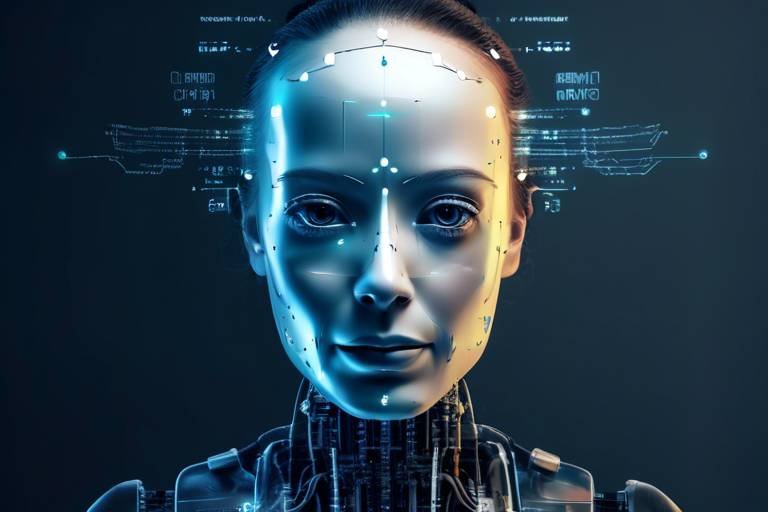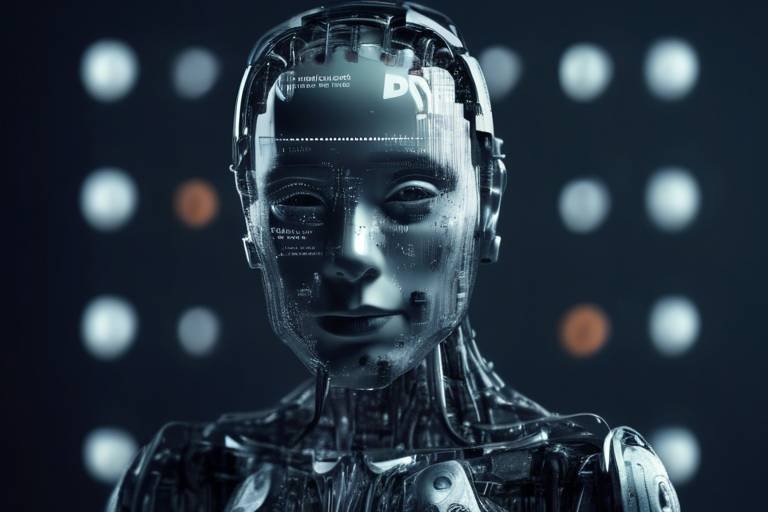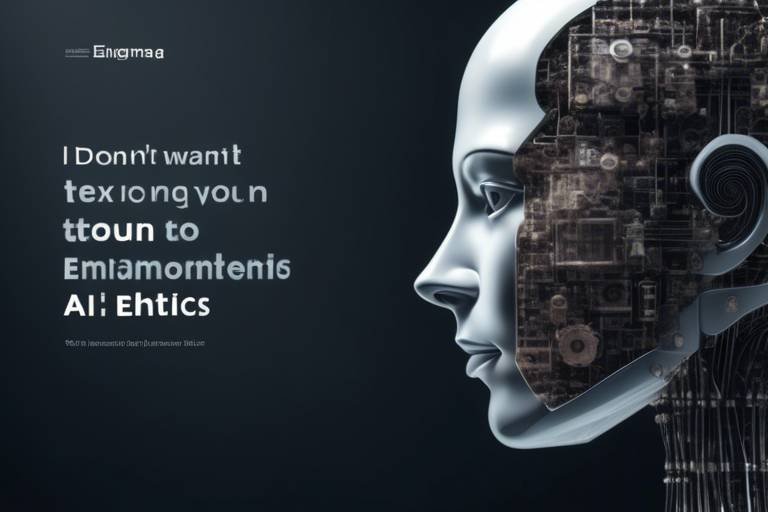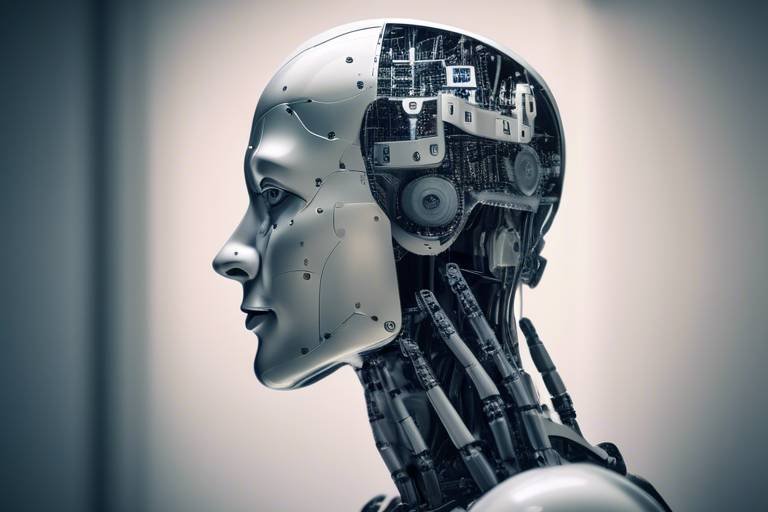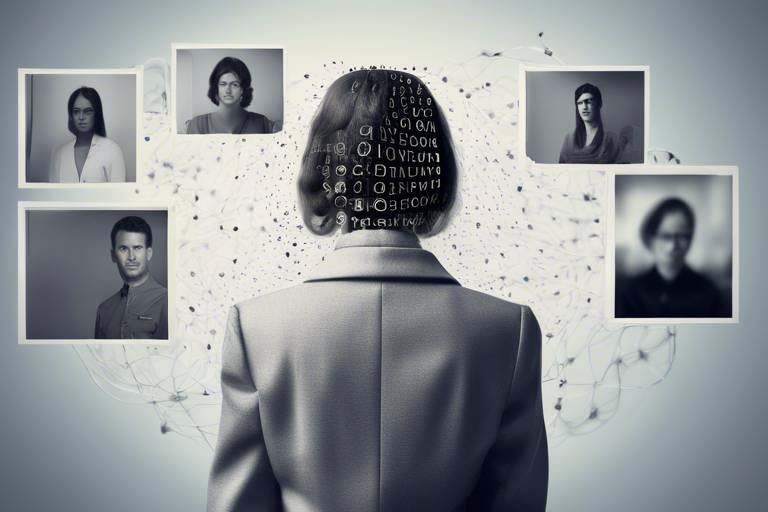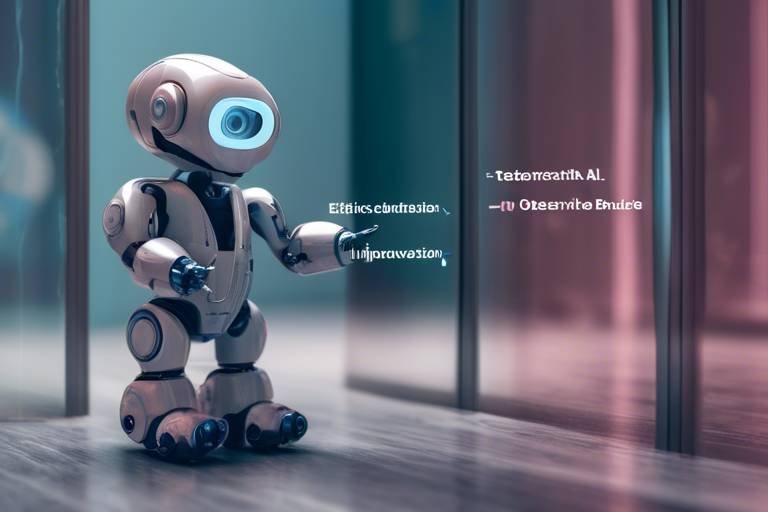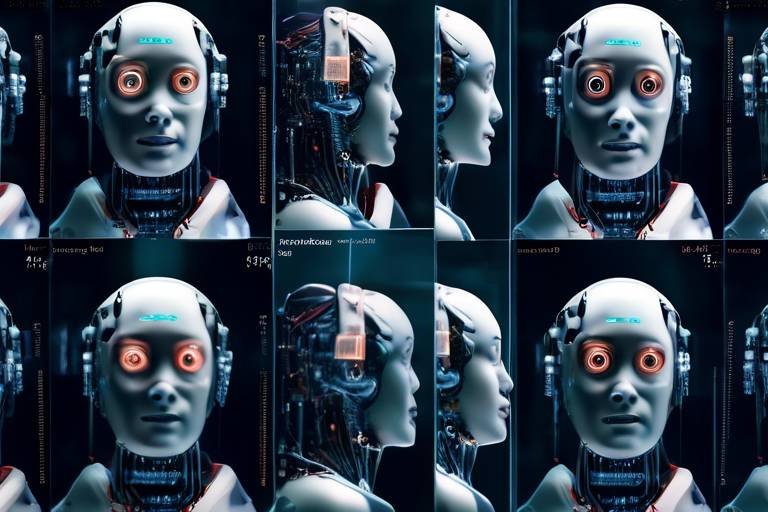Dissecting the Thin Line between AI and Ethics
The rapid advancement of artificial intelligence (AI) has ushered in a new era of technological possibilities, but it also raises profound ethical questions that we can no longer ignore. Picture a world where machines not only assist us but also make decisions that impact our lives. This scenario is not far-fetched; it’s happening right now. As AI technologies permeate various sectors—from healthcare to finance to law enforcement—the need to examine the ethical implications of these systems becomes increasingly critical. How do we ensure that these powerful tools are used responsibly? What moral responsibilities do developers bear when creating AI systems? These questions form the crux of the ongoing dialogue about AI and ethics.
At the heart of this discussion lies the understanding that AI does not operate in a vacuum. It is built on data that reflects human biases, societal norms, and historical injustices. The algorithms that power AI systems can inadvertently perpetuate these biases, leading to outcomes that are not just unfair but also harmful. For instance, consider a hiring algorithm that favors candidates from certain demographics based on skewed training data. This not only impacts the lives of individuals but can also skew entire industries towards inequity. As we dive deeper into this complex relationship between AI and ethics, we must confront the uncomfortable truth that the technology we create can either bridge gaps or widen them.
Moreover, the ethical landscape of AI is not static; it evolves as technology advances. Each breakthrough comes with its own set of ethical dilemmas. Imagine a self-driving car faced with an unavoidable accident—should it prioritize the safety of its passengers over pedestrians? Such scenarios force us to confront our values and the principles we want our technologies to uphold. Thus, the conversation around AI and ethics is not just about compliance with regulations but also about fostering a culture of responsibility and accountability in technology development.
As we navigate this intricate web of ethical considerations, it becomes evident that collaboration is key. Stakeholders—developers, policymakers, and the public—must come together to create a framework that promotes ethical AI practices. This includes establishing guidelines for responsible data use, ensuring transparency in AI decision-making processes, and implementing robust mechanisms for accountability. Only through collective effort can we hope to harness the full potential of AI while safeguarding our ethical standards.
In the following sections, we will delve deeper into specific ethical implications of AI, including bias in algorithms, privacy concerns, and the need for regulatory frameworks. Each of these aspects plays a crucial role in shaping the future of AI, and understanding them is essential for anyone who wishes to engage with this transformative technology responsibly.
- What are the main ethical issues surrounding AI? The primary ethical issues include bias in algorithms, privacy concerns, and the accountability of AI systems.
- How can we mitigate bias in AI? Mitigating bias involves using diverse data sets, ensuring transparency in algorithm development, and continuous monitoring of AI systems.
- Why is privacy a concern with AI? AI systems often require large amounts of personal data, which can infringe on individual privacy rights if not handled properly.
- What role do regulations play in AI ethics? Regulations help establish legal frameworks that protect user data and ensure ethical compliance in AI technologies.
- What does the future hold for ethical AI? The future will likely see ongoing discussions about balancing innovation with ethical responsibility, especially as AI technologies continue to evolve.

The Ethical Implications of AI
As we dive into the realm of artificial intelligence, it's crucial to first acknowledge the vast ethical implications that accompany this groundbreaking technology. AI isn't just about algorithms and data; it's about the moral responsibilities that come with creating systems that can influence our lives in profound ways. Imagine a world where machines make decisions that affect your daily life—your job, your healthcare, your privacy. The stakes are incredibly high, and the question arises: who is responsible when things go awry?
One of the most pressing issues is the potential for bias in AI applications. When developers create algorithms, they often rely on historical data to train these systems. However, if that data contains biases—whether intentional or unintentional—those biases can be perpetuated and even amplified by AI. This raises serious concerns about fairness and equity, especially in sectors like hiring, law enforcement, and lending. For instance, if an AI system is trained on data that reflects societal prejudices, it may inadvertently discriminate against certain groups, leading to unjust outcomes.
Moreover, the issue of privacy cannot be overlooked. In our quest for innovation, we often sacrifice personal privacy without even realizing it. AI systems frequently collect vast amounts of data to function effectively. This data can include sensitive personal information, which poses significant risks if not handled properly. What happens to your data once it's collected? Who has access to it? These are questions that demand answers, as the intersection of AI and privacy continues to evolve.
Additionally, we must consider the impact of AI on human decision-making. As AI systems become more autonomous, there's a growing concern that they might overshadow human judgment. Imagine a scenario where an AI system determines the best course of action in a medical emergency without human input. While AI can process data at lightning speed, it lacks the emotional intelligence and ethical reasoning that human beings possess. This raises a critical question: should we allow machines to make decisions that have significant consequences for human lives?
In light of these challenges, it becomes evident that we need a comprehensive approach to address the ethical implications of AI. This includes not only developing robust guidelines for AI developers but also fostering an ongoing dialogue among stakeholders, including technologists, ethicists, and the general public. By doing so, we can work towards a future where AI technologies are not only innovative but also responsible and ethical.
Ultimately, the relationship between AI and ethics is a complex one, filled with challenges and opportunities. As we continue to explore this uncharted territory, it's imperative that we remain vigilant and proactive in addressing these ethical concerns. The future of AI holds immense potential, but it is our collective responsibility to ensure that this potential is harnessed in a manner that respects human dignity and promotes social good.
- What are the main ethical concerns surrounding AI?
Key concerns include bias, privacy, and the impact of AI on human decision-making. - How can we mitigate bias in AI systems?
Utilizing diverse data sets, ensuring transparency, and ongoing monitoring are essential strategies. - What role do regulations play in ethical AI development?
Regulations help establish standards and accountability for AI technologies to protect users and promote ethical practices. - Why is privacy a significant issue in AI?
AI systems often collect and analyze personal data, raising concerns about how this data is used and who has access to it.

Bias in AI Algorithms
As we dive deeper into the world of artificial intelligence, one of the most pressing issues that emerges is the concept of . This bias doesn't just exist in a vacuum; it has real-world consequences that can affect the lives of countless individuals. Imagine a world where a simple algorithm, designed to assist in hiring, inadvertently favors one demographic over another. This is not just a theoretical concern; it’s a reality that we must confront. The data we feed into these algorithms can carry the weight of societal prejudices, leading to outcomes that reinforce existing inequalities.
At the heart of the problem lies the training data used to develop AI systems. If the data is skewed or lacks diversity, the resulting algorithms will likely reflect those same biases. For instance, a facial recognition system trained predominantly on images of light-skinned individuals may struggle to accurately identify people with darker skin tones. This not only raises ethical questions but also highlights a significant flaw in the design process. The implications are profound, affecting areas such as law enforcement, hiring practices, and even healthcare.
To better understand the implications of bias in AI, let's consider some key areas where this issue is particularly prevalent:
- Hiring Algorithms: Many companies use AI to screen resumes and shortlist candidates. If these algorithms are trained on historical hiring data that reflects bias against certain groups, they may perpetuate that bias in future hiring decisions.
- Credit Scoring: AI systems that assess creditworthiness can inadvertently discriminate against individuals from certain backgrounds, leading to unfair denial of loans or credit.
- Law Enforcement: Predictive policing tools, which analyze crime data to allocate police resources, can disproportionately target communities of color, leading to over-policing in those areas.
These examples illustrate a crucial point: bias in AI algorithms is not merely a technical issue; it is a societal one. It challenges our understanding of fairness and equality in a world increasingly driven by technology. As AI continues to evolve, the need for fairness and inclusivity in algorithm development becomes paramount. Developers must actively seek to create algorithms that are not only effective but also equitable.
So, how do we tackle the issue of bias in AI? One effective strategy is to use diverse datasets that accurately reflect the demographics of the population. This approach can help ensure that AI systems are more representative and less likely to produce biased outcomes. Additionally, implementing transparency measures allows stakeholders to understand how algorithms make decisions, fostering trust and accountability. Continuous monitoring and auditing of AI systems are also essential to identify and rectify biases as they arise.
Ultimately, addressing bias in AI algorithms is about more than just improving technology; it’s about upholding ethical standards in a rapidly changing world. By prioritizing fairness and inclusivity, we can work towards AI systems that serve all individuals equitably, paving the way for a more just society.

Case Studies of AI Bias
When we talk about AI bias, it’s not just a theoretical concern—it's a reality that has impacted lives and shaped societal structures. One of the most notorious examples is the Facial Recognition Technology used by law enforcement agencies. Studies have shown that these systems often misidentify people of color at alarming rates compared to their white counterparts. For instance, a report from the MIT Media Lab revealed that facial recognition algorithms misidentified darker-skinned women 34% of the time, while misidentifying lighter-skinned men only 1%. This disparity raises serious questions about the ethical implications of deploying such technology without rigorous checks and balances.
Another striking case is the COMPAS algorithm, which is used in the criminal justice system to assess the likelihood of a defendant reoffending. ProPublica conducted a study that uncovered significant racial bias in its predictions. The algorithm was found to incorrectly flag African American defendants as high-risk nearly twice as often as white defendants. This not only affects sentencing but also perpetuates systemic inequalities within the justice system. The repercussions of these biases can lead to devastating outcomes for individuals and communities alike.
In the realm of hiring, AI systems like Amazon's recruitment tool faced backlash for showing bias against female candidates. The AI was trained on resumes submitted to the company over a ten-year period, which were predominantly from men. As a result, the algorithm developed a preference for male candidates, penalizing resumes that included the word "women’s." This case exemplifies how biases can be inadvertently baked into AI systems, leading to discriminatory hiring practices that further entrench gender disparities in the workforce.
These cases illustrate a critical point: AI bias is not just a technical flaw; it’s a societal issue that can have real-world consequences. It’s essential for developers to adopt a proactive approach to identify and mitigate biases in AI systems. This includes employing diverse datasets, conducting regular audits, and engaging with affected communities to understand the impact of their technologies. By doing so, we can move towards a future where AI serves as a tool for equity rather than a mechanism of oppression.
To encapsulate the urgency of addressing AI bias, consider the following table that summarizes key case studies and their implications:
| Case Study | Technology | Bias Type | Impact |
|---|---|---|---|
| Facial Recognition | Law Enforcement | Racial Bias | Misidentification of individuals of color |
| COMPAS | Criminal Justice | Racial Bias | Disproportionate sentencing of African Americans |
| Amazon Recruitment Tool | Hiring | Gender Bias | Discriminatory hiring practices against women |
By analyzing these case studies, it becomes evident that the stakes are high when it comes to AI bias. The responsibility lies not only with tech companies but with all stakeholders involved in the AI ecosystem. As we push towards more innovative solutions, we must also ensure that these solutions are just and equitable.
- What is AI bias? AI bias refers to systematic and unfair discrimination that occurs when AI systems produce results that are prejudiced due to erroneous assumptions in the machine learning process.
- How can AI bias be mitigated? Mitigating AI bias involves using diverse datasets, regular audits, and involving a variety of stakeholders in the development process to ensure fairness and inclusivity.
- Why is AI bias a concern? AI bias is a concern because it can lead to real-world consequences, such as discrimination in hiring, law enforcement, and lending, further entrenching societal inequalities.

Solutions to Combat AI Bias
Addressing the issue of bias in artificial intelligence is not just a technical challenge; it is a moral imperative. As we dive deeper into the realm of AI, the question arises: how can we ensure that these systems are fair and just? One effective strategy is to diversify training data. By incorporating a wide range of perspectives and experiences into the datasets used to train AI models, we can mitigate the risk of perpetuating existing biases. This means actively seeking out data that represents various demographics, cultures, and social backgrounds. Imagine trying to build a bridge; if you only use materials from one source, the structure may not hold up against diverse conditions. Similarly, AI needs a robust foundation built on a variety of data inputs to function effectively across different populations.
Another critical solution is to promote transparency in AI algorithms. Developers should strive to create models that are not only effective but also understandable. This involves documenting the decision-making processes and the data sources used in AI systems. Transparency allows stakeholders, including users and regulatory bodies, to scrutinize the algorithms and identify potential biases. Think of it as a recipe: if you know all the ingredients and their proportions, you can better understand how the final dish was created. In AI, this understanding can lead to more equitable outcomes.
Continuous monitoring is also essential in the fight against AI bias. Once an AI system is deployed, it should not be left to operate in isolation. Regular audits and assessments can help identify biases that may emerge over time as the system interacts with new data. This is akin to maintaining a vehicle; regular check-ups ensure that everything runs smoothly and safely. By implementing a routine evaluation process, organizations can adapt their AI systems to changing conditions and rectify any biases that arise.
Moreover, fostering a diverse team of developers is crucial. A group of individuals with different backgrounds, experiences, and perspectives is more likely to recognize and address potential biases in AI systems. This diversity can lead to more innovative solutions and a better understanding of how different communities might be affected by AI technologies. Just as a symphony needs various instruments to create a harmonious sound, the development of AI benefits from a multitude of voices contributing to its design.
In addition to these strategies, regulatory frameworks can play a significant role in combating AI bias. Governments and organizations should establish guidelines that mandate fairness and inclusivity in AI development. By setting clear standards, we can hold companies accountable and ensure that ethical considerations are not an afterthought. For instance, implementing policies that require companies to report on the demographic impacts of their AI systems can drive change and promote fairness.
Finally, education and awareness are key components in the effort to combat AI bias. By educating developers, stakeholders, and users about the implications of biased AI, we can create a culture that values ethical considerations. Workshops, seminars, and online courses can equip individuals with the knowledge needed to identify and combat bias in AI. Just as we teach future generations about the importance of fairness in society, we must also instill these values in the realm of technology.
Combating AI bias is a multifaceted challenge that requires a combination of diverse data, transparency, continuous monitoring, diverse teams, regulatory frameworks, and education. By embracing these solutions, we can pave the way for a future where AI serves all of humanity equitably.
- What is AI bias? AI bias refers to the systematic and unfair discrimination that can occur when AI systems produce results that are prejudiced due to flawed data or algorithms.
- How can I identify bias in AI systems? Bias can often be identified by analyzing the outcomes of AI decisions and comparing them across different demographic groups to see if there are disparities.
- Why is diversity important in AI development? Diversity in AI development helps ensure that a variety of perspectives are considered, which can lead to fairer and more inclusive AI systems.
- What role does regulation play in AI bias? Regulation can establish standards and accountability, ensuring that AI systems are developed and deployed ethically, reducing the risk of bias.

The Role of Regulation
In the rapidly evolving world of artificial intelligence, regulation plays a crucial role in ensuring that ethical standards are not only proposed but also implemented effectively. As AI technologies continue to advance, the potential for misuse and harmful consequences grows, making it imperative for governments and organizations to establish comprehensive regulatory frameworks. These frameworks serve as a guiding light, ensuring that AI developers and companies adhere to ethical practices while fostering innovation.
One of the primary objectives of regulation is to create a balance between innovation and responsibility. Without proper oversight, the race to develop cutting-edge AI solutions can lead to neglecting ethical considerations. For instance, consider the development of autonomous vehicles. While the technology promises to reduce traffic accidents and improve transportation efficiency, it also raises significant ethical questions regarding accountability in the event of an accident. Regulations can help clarify liability issues, ensuring that developers take moral responsibility for their creations.
Moreover, regulations can help mitigate the risks associated with data privacy and security. With AI systems often relying on vast amounts of personal data, the potential for breaches and misuse is a pressing concern. Regulatory frameworks like the General Data Protection Regulation (GDPR) in Europe have set a precedent for how data should be handled, emphasizing the importance of user consent and data protection. These regulations not only protect individuals but also build trust in AI technologies, encouraging wider adoption.
To illustrate the importance of regulation in AI, let’s look at a few key areas where it can make a significant impact:
- Accountability: Regulations can establish clear lines of responsibility for AI outcomes, ensuring that developers are held accountable for their systems.
- Transparency: By requiring transparency in AI algorithms and decision-making processes, regulations can help demystify how AI systems operate, allowing users to understand and trust the technology.
- Fairness: Regulatory frameworks can enforce standards for fairness, helping to prevent discriminatory practices in AI applications.
However, creating effective regulations is not without its challenges. Policymakers must navigate the fast-paced nature of AI development, which often outstrips existing legal frameworks. Additionally, there is a risk that overly stringent regulations could stifle innovation, making it crucial to strike the right balance. Engaging with stakeholders, including AI developers, ethicists, and the public, is essential to crafting regulations that are both effective and conducive to growth.
In conclusion, the role of regulation in AI development cannot be overstated. As we stand on the brink of an AI-driven future, robust regulatory frameworks will be essential in ensuring that technology serves humanity ethically and responsibly. By fostering innovation while safeguarding ethical standards, regulations can help shape a future where AI enhances our lives without compromising our values.
Q1: Why is regulation necessary for AI?
A1: Regulation is essential to ensure that AI technologies are developed and deployed ethically, protecting users' rights and promoting accountability among developers.
Q2: How can regulations impact AI innovation?
A2: While regulations can impose certain constraints, they can also foster innovation by building trust in AI technologies and ensuring that ethical considerations are integrated into development processes.
Q3: What are some examples of existing AI regulations?
A3: Notable examples include the General Data Protection Regulation (GDPR) in Europe, which governs data privacy, and various guidelines proposed by organizations like the IEEE and the OECD focused on ethical AI development.

Ethical AI Development Frameworks
In the rapidly evolving world of artificial intelligence, establishing robust is crucial for guiding developers and organizations in creating responsible AI systems. These frameworks serve as a roadmap, ensuring that ethical considerations are integrated into every stage of the AI lifecycle, from conception to deployment. But what exactly do these frameworks entail, and why are they so important?
At the core of ethical AI development frameworks are principles such as accountability, transparency, and stakeholder engagement. Accountability ensures that AI developers are responsible for the outcomes of their systems, encouraging them to consider the potential impacts on society. Transparency involves making the workings of AI systems understandable to users and stakeholders, fostering trust and enabling informed decision-making. Finally, stakeholder engagement emphasizes the importance of involving diverse voices in the development process, ensuring that multiple perspectives are considered to avoid biases and promote inclusivity.
One prominent example of an ethical AI framework is the AI Ethics Guidelines developed by the European Commission. These guidelines outline essential requirements for trustworthy AI, which include:
- Human oversight: Ensuring that AI systems remain under human control to prevent harmful outcomes.
- Technical robustness: Developing AI systems that are reliable and safe, minimizing risks of unintended consequences.
- Privacy and data governance: Upholding data protection principles to safeguard user privacy.
- Transparency: Providing clear information about AI systems and their decision-making processes.
- Fairness: Striving for non-discrimination and inclusivity in AI applications.
These principles not only guide developers but also provide a framework for organizations to evaluate their AI practices. By adhering to these guidelines, companies can mitigate risks associated with AI deployment, such as bias and privacy violations, ultimately fostering a culture of ethical responsibility.
Moreover, implementing ethical AI frameworks can enhance a company's reputation and build consumer trust. In a world where users are increasingly concerned about the implications of technology on their lives, demonstrating a commitment to ethical practices can be a significant competitive advantage. Organizations that prioritize ethical AI are more likely to attract customers who value corporate responsibility and social impact.
However, the journey toward ethical AI is not without its challenges. As technology continues to advance at an unprecedented pace, the frameworks must evolve to address new ethical dilemmas. This requires ongoing dialogue among developers, ethicists, policymakers, and the public to ensure that the frameworks remain relevant and effective. Collaborative initiatives, such as industry partnerships and academic research, can play a vital role in shaping the future of ethical AI development.
In conclusion, establishing and adhering to ethical AI development frameworks is essential for navigating the complexities of AI technology. By prioritizing accountability, transparency, and stakeholder engagement, developers can create AI systems that not only drive innovation but also respect human rights and societal values. As we move forward, the importance of these frameworks will only grow, guiding us toward a future where AI serves as a force for good.
- What are ethical AI development frameworks? These are guidelines that help developers create AI systems responsibly, ensuring accountability, transparency, and inclusivity.
- Why is transparency important in AI? Transparency builds trust among users and stakeholders, allowing them to understand how AI systems make decisions.
- How can organizations implement ethical AI frameworks? By adopting established guidelines, engaging diverse stakeholders, and continuously monitoring AI systems for ethical compliance.

Privacy Concerns with AI
The rapid advancement of artificial intelligence (AI) has ushered in a new era of technological innovation, but it also raises significant privacy concerns that cannot be ignored. As AI systems become more integrated into our daily lives, the way they collect, analyze, and utilize personal data is increasingly under scrutiny. Imagine a world where your every move, preference, and interaction is meticulously recorded and analyzed by machines—sounds a bit unsettling, right? This is the reality we face as AI technologies evolve, and it’s crucial to address the implications of such capabilities.
At the heart of these privacy concerns lies the issue of data collection. AI systems often rely on vast amounts of data to function effectively. This data can include everything from social media activity to health information, leading to a treasure trove of personal insights. While this data can enhance user experiences and improve service delivery, it also poses a risk of misuse. Who has access to this data? How is it being used? These are questions that demand answers, especially when considering the potential for data breaches or unauthorized surveillance.
Moreover, the lack of transparency in how AI algorithms operate exacerbates these privacy issues. Many users are unaware of how their data is being utilized or the extent of its reach. For instance, consider the case of targeted advertising, where companies use AI to analyze user behavior and preferences. While this can lead to more relevant ads, it also raises ethical questions about consent and the right to privacy. Are users truly informed about how their data is being collected and used? Or are they navigating a digital landscape where their information is exploited without their knowledge?
To illustrate the gravity of these concerns, let’s take a look at some of the most pressing privacy issues associated with AI:
- Informed Consent: Users often do not fully understand what they are consenting to when they agree to data collection practices.
- Data Security: With the increase in data breaches, sensitive personal information can fall into the wrong hands, leading to identity theft and other crimes.
- Surveillance: The potential for AI to be used in surveillance systems raises ethical questions about monitoring individuals without their consent.
As we navigate these challenges, the importance of robust privacy protections in AI systems cannot be overstated. Regulatory frameworks, such as the General Data Protection Regulation (GDPR), have been established to safeguard user data and ensure ethical compliance. These regulations mandate that organizations implement stringent data protection measures, including obtaining explicit consent from users before collecting their information. However, while regulations are a step in the right direction, they are not a panacea. Continuous dialogue and adaptation are necessary to keep pace with the rapidly evolving landscape of AI technology.
In conclusion, the intersection of AI and privacy is a complex battlefield where innovation meets ethical responsibility. As we embrace the benefits of AI, we must also prioritize our right to privacy. This requires a collective effort from developers, regulators, and users alike to foster an environment where technological advancement does not come at the expense of individual rights. Only then can we ensure a future where AI serves humanity without compromising our privacy.
- What are the main privacy concerns related to AI? Privacy concerns include data collection practices, lack of transparency, informed consent, and potential misuse of personal information.
- How does GDPR protect user data? GDPR mandates that organizations must obtain explicit consent before collecting personal data and implement strict security measures to protect that data.
- What can individuals do to protect their privacy in the age of AI? Individuals can be proactive by understanding privacy policies, using privacy-focused tools, and being cautious about the information they share online.

Data Protection Regulations
In our increasingly digital world, have become more crucial than ever, especially as artificial intelligence (AI) technologies continue to evolve. These regulations are designed to safeguard personal information and ensure that organizations handle data responsibly. One of the most significant frameworks in this realm is the General Data Protection Regulation (GDPR), which was implemented in the European Union in 2018. GDPR sets stringent guidelines for the collection and processing of personal data, emphasizing the need for transparency and consent.
But what does this mean for AI? Well, AI systems often rely on vast amounts of data to learn and make decisions. Without clear regulations, there’s a risk that personal data could be mishandled, leading to breaches of privacy and trust. For instance, imagine a scenario where an AI-driven healthcare application uses sensitive patient data without proper consent. This not only jeopardizes patient privacy but also raises ethical questions about the responsibility of developers and organizations in protecting user data.
To illustrate the importance of data protection regulations, consider the following table that outlines key aspects of GDPR:
| Aspect | Description |
|---|---|
| Consent | Individuals must give explicit consent for their data to be processed. |
| Right to Access | Individuals have the right to access their personal data and understand how it is used. |
| Data Portability | Individuals can transfer their data between service providers easily. |
| Right to be Forgotten | Individuals can request the deletion of their personal data under certain conditions. |
These regulations not only protect individual rights but also compel organizations to adopt ethical practices when developing AI systems. By ensuring compliance with regulations like GDPR, companies can foster greater trust among users, which is essential in a world where data breaches are becoming alarmingly common. It’s like building a fortress around personal information; the stronger the walls, the less likely it is that intruders can gain access.
Moreover, the global nature of the internet means that data protection regulations are not limited to the EU. Countries around the world are beginning to recognize the importance of similar frameworks. For example, California's Consumer Privacy Act (CCPA) offers many of the same protections as GDPR, demonstrating a growing trend towards stringent data privacy laws. This shift emphasizes the need for AI developers to stay informed about various regulations and ensure their technologies comply with local laws.
In conclusion, as AI continues to permeate our lives, will play a pivotal role in shaping how these technologies are developed and implemented. They serve as a necessary check on the power of AI, ensuring that while we embrace innovation, we do not compromise the fundamental rights of individuals. As we move forward, it’s imperative that both developers and users engage in ongoing discussions about the ethical implications of AI and the importance of robust data protection.
- What is GDPR? GDPR stands for General Data Protection Regulation, a comprehensive data protection law in the EU.
- Why are data protection regulations important for AI? They ensure that personal data is handled responsibly, protecting individual privacy and fostering trust.
- How can organizations comply with data protection regulations? By implementing transparent data practices, obtaining user consent, and ensuring data security.

Future of Ethical AI
The future of ethical AI is a topic that is both exciting and daunting. As we stand on the brink of technological advancements that were once the stuff of science fiction, we must consider how these innovations will shape our moral landscape. Imagine a world where machines not only assist us but also make decisions that could impact our lives in profound ways. This scenario raises a crucial question: how do we ensure that these AI systems operate under a framework of ethical guidelines?
One of the primary challenges we face is the rapid pace of AI development. With each breakthrough, we are confronted with new ethical dilemmas. For instance, as AI systems become more autonomous, the question of accountability becomes increasingly complex. If an AI makes a decision that leads to harm, who is responsible? The developer, the user, or the AI itself? This ambiguity necessitates a robust dialogue among technologists, ethicists, lawmakers, and the public to establish clear guidelines on accountability.
Moreover, as AI continues to integrate into various sectors—healthcare, finance, and even law enforcement—the potential for misuse grows. The need for ethical AI frameworks is more pressing than ever. These frameworks should not only address the current challenges but also anticipate future risks. They must be adaptable, allowing for revisions as technology evolves and new ethical concerns arise.
To illustrate the importance of proactive measures, consider the following potential developments in ethical AI:
- Increased Collaboration: Future ethical AI development will likely involve collaboration between multiple stakeholders, including technologists, ethicists, and community representatives. This diverse input can help create a more comprehensive ethical framework.
- Transparency and Explainability: As AI systems become more complex, ensuring that they are transparent and can explain their decision-making processes will be crucial. Users must understand how and why decisions are made to trust these systems.
- Continuous Monitoring: Just as we monitor environmental changes, we will need to continuously assess the impact of AI on society. This ongoing evaluation can help identify and mitigate ethical risks before they escalate.
As we look to the future, it is essential to foster a culture of ethical responsibility within the AI community. This means not only adhering to ethical guidelines but also advocating for the rights and well-being of all individuals affected by AI technologies. By prioritizing ethics in AI development, we can harness the power of technology to create a better, more equitable world.
In conclusion, the future of ethical AI hinges on our ability to navigate the complexities of technology and morality. It requires a collective effort to establish frameworks that prioritize human rights and dignity. As we embrace the possibilities of AI, let us not forget the importance of ethical considerations in shaping a future that benefits everyone.
- What is ethical AI? Ethical AI refers to the development and deployment of artificial intelligence systems that prioritize fairness, accountability, transparency, and respect for human rights.
- Why is AI ethics important? AI ethics is crucial because AI systems can significantly impact society, and ensuring they operate within ethical boundaries helps prevent harm and promotes trust.
- How can we ensure ethical AI development? Ensuring ethical AI development involves creating comprehensive frameworks, fostering collaboration among stakeholders, and continuously monitoring AI's societal impact.
- What role do regulations play in ethical AI? Regulations provide a legal framework that can guide ethical AI development, ensuring compliance with established standards and protecting individual rights.
Frequently Asked Questions
- What are the main ethical implications of AI?
The ethical implications of AI are vast and complex. They include concerns about bias in algorithms, privacy issues, and the potential impact on human decision-making. As AI systems become more integrated into our daily lives, understanding these implications is crucial for developers and users alike.
- How does bias occur in AI algorithms?
Bias in AI algorithms typically arises from the training data used to develop these systems. If the data reflects existing societal biases or lacks diversity, the AI can produce discriminatory outcomes. This highlights the importance of ensuring fairness and inclusivity during the algorithm development process.
- Can you give examples of AI bias?
Absolutely! One notable example is facial recognition technology, which has shown higher error rates for people of color compared to white individuals. Another case is in hiring algorithms that may favor male candidates over female ones due to biased training data. These examples underscore the urgent need for corrective measures in AI design.
- What solutions exist to combat AI bias?
There are several strategies to combat AI bias, including using diverse and representative data sets, ensuring transparency in algorithm development, and implementing continuous monitoring of AI systems. These measures can help create more equitable outcomes for all users and mitigate the risks associated with biased algorithms.
- Why is regulation important in AI development?
Regulation is essential in AI development to ensure that ethical standards are maintained while still fostering innovation. By establishing clear guidelines, regulations can help prevent harmful outcomes, protect user rights, and promote accountability among AI developers.
- What are some ethical AI development frameworks?
Several ethical AI development frameworks exist, focusing on principles such as accountability, transparency, and stakeholder engagement. These frameworks guide developers in creating AI systems that prioritize ethical considerations throughout the AI lifecycle, from design to deployment.
- How does AI affect personal privacy?
AI can significantly impact personal privacy through data collection practices that may infringe on individual rights. As AI systems often require vast amounts of data to function effectively, there is a pressing need for robust privacy protections to safeguard user information and maintain trust.
- What are data protection regulations like GDPR?
Data protection regulations, such as the General Data Protection Regulation (GDPR), play a crucial role in safeguarding user data. These laws set out strict guidelines for data collection, processing, and storage, ensuring that AI technologies comply with ethical standards and respect individual privacy rights.
- What does the future hold for ethical AI?
The future of ethical AI is likely to be shaped by ongoing discussions about the balance between innovation and ethical responsibility. As emerging technologies continue to evolve, the dialogue surrounding AI ethics will remain critical in guiding developers and policymakers toward creating a fair and just technological landscape.

